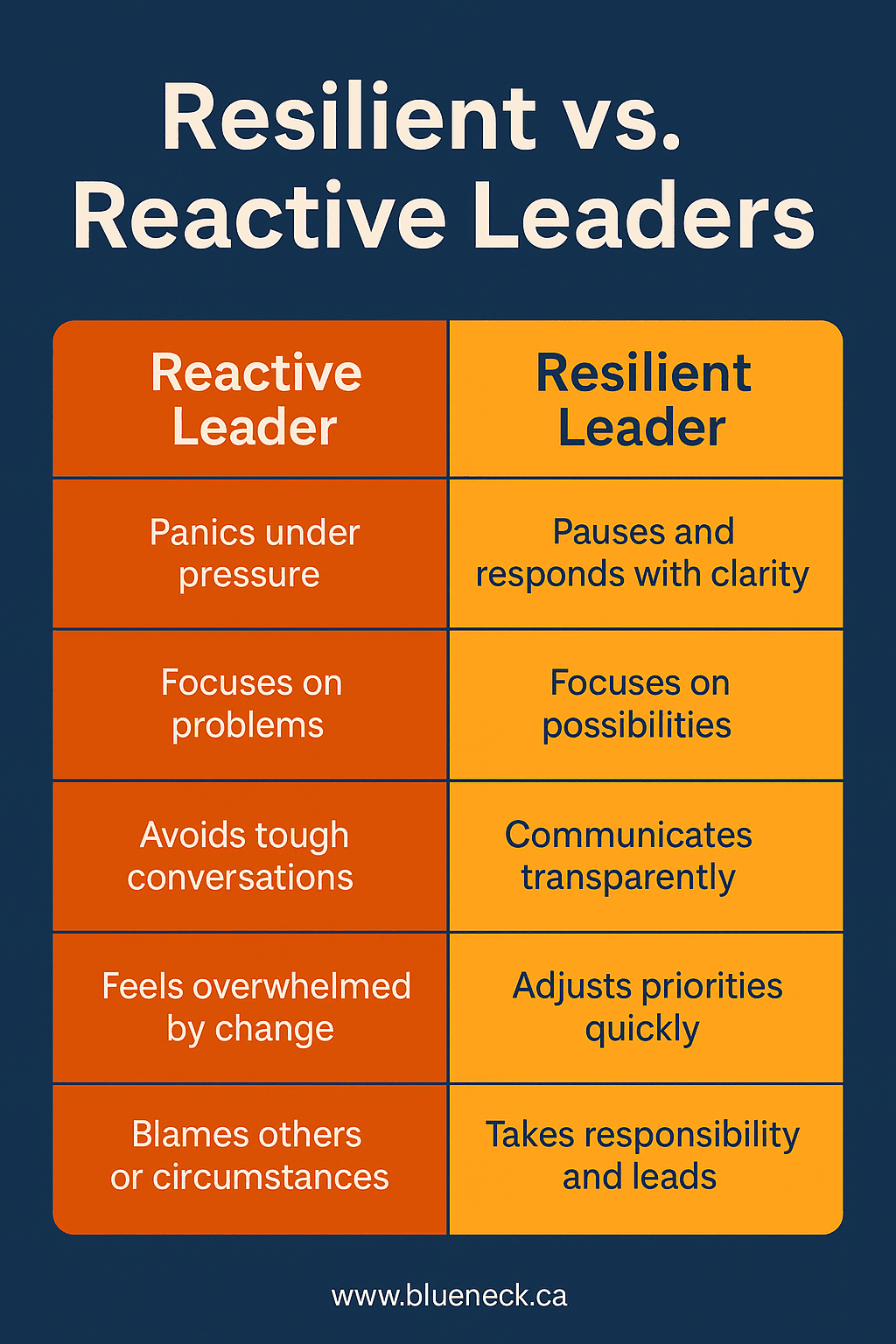
Steady Leadership Starts with Resilience
Business change is a given, but it seems like it’s been a rollercoaster over the past year. One month, there are record sales; the next, a key supplier fails to deliver. You’re facing staffing shortages, inflation pressures, and delayed shipments while trying to remain stable for your team.
Sound familiar?
For the leaders of blue-collar businesses across Canada, this type of volatility, particularly with companies between 5 and 50 employees, is increasingly the new normal. In an environment like this, resilience is not just about staying steady — it’s about how you respond.
Blueneck Consulting is a Canadian owned company that helps business owners and senior leaders become more effective when leading through the unknown. This article provides practical strategies for building adaptive resilience – the kind that helps leaders remain focused, steady, and forward-moving even after being blindsided.
Resilient leadership starts with mindset — but it needs systems to back it up. If supply chain delays, price hikes, or vendor issues have been testing your team, check out our recent article, “Supply Chain Snarls: Are You Ready?” for practical ways to build operational resilience and protect your business from future disruption.

What Is Adaptive Resilience?
To many, resilience is a mystery. It’s not about “toughing it out” or putting on a brave face: real leadership resilience is about adaptability and recovery, about leading purposefully in rapidly changing circumstances.
According to the American Psychological Association, resilience is “the process of adapting well in the face of adversity, trauma, tragedy, threats or significant sources of stress."
In a leadership context, adaptive resilience shows up when:
Adaptive resilience means staying flexible under pressure, without losing clarity or direction. It’s what separates reactive managers from confident leaders.
Why Resilience Matters for Blue-Collar Business Leaders
Stress is part of the job in companies with physical work, tight deadlines, and high customer demands. But when stress piles up, especially at the top, it trickles down, damaging culture, performance, and team morale.
Here’s what we’ve seen at Blueneck:
- Based on a Gallup workplace report, businesses that foster resilience have 25% higher employee engagement.
- Teams with strong leadership are twice as likely to adapt successfully to significant changes, like market shifts or operational disruptions.
- Leaders who invest in their development make faster, more aligned decisions, even in moments of uncertainty.
In other words, resilience isn’t a soft skill. It’s a business advantage.
Resilient vs. Reactive Leaders

To lead effectively through chaos, it helps to recognize the difference between reacting and responding. Here’s a side-by-side comparison to keep in mind.
Leadership Tip: When you catch yourself in a reactive mode, pause for 30 seconds. Breathe. Then ask yourself: What does my team need from me right now?
This simply shift moves you from stress to strategy.
5 Ways to Build Resilient Leaders in High-Change Environments
So how can you strengthen resilience in yourself and your leadership team? Here’s where to start:
1. Normalize the Unexpected
1. Normalize the Unexpected
Don't view them as failures when disruptions happen (and they will). Instead, view them as part of growth.
Resilient leaders acknowledge challenges without dramatizing them. This helps teams stay calm, focused, and solutions oriented.
Tip: Practice “transparent calm.” Be transparent with your team about what is happening, but model a steady tone. Say things such as, “Here’s what has changed, here’s what we’re doing, and here’s what I need from you.”
2. Shift From Reaction to Reflection
2. Shift From Reaction to Reflection
Pause before you act. It’s tempting to jump into problem-solving mode in the moment. But resilient leaders create space to reflect before reacting.
Try this three-step approach:
- Pause: Take a breath — literally. Even a 30-second pause can reset your stress response.
- Assess: What’s the core issue here? What needs attention now, and what can wait?
- Respond: Choose a course of action that aligns with your values, not your stress.
This simple pause improves decision-making, especially in high-pressure moments.
3. Build a Culture of Flexibility
3. Build a Culture of Flexibility
Your team’s resilience mirrors yours. If leaders panic under pressure, the team will, too. But if leaders stay composed, open, and adaptable, teams feel safer following suit.
One way to do this is by embedding flexibility into the culture:
- Offer adaptable work shifts when possible.
- Create room for cross-training to handle absence.
- Encourage team check-ins during busy weeks.
A 2023 Deloitte study found that high-psychologically safe teams were 31% more productive than those lower on safety, and 27% more innovative. A flexible, human-centered culture isn’t simply “nice” — it’s effective.
4. Strengthen Leadership Through Coaching and Development
4. Strengthen Leadership Through Coaching and Development
Leadership resilience built, not born. Regular leadership coaching serves to refine self-awareness, emotional control, and pressure decision-making.
At Blueneck, we serve blue-collar industry leaders who excel at their craft but require guidance in people leadership. We coach leaders to:
- Communicate clearly under pressure.
- Align decisions with company values.
- Stay grounded during uncertainty.
Simple changes like learning to give better feedback or navigate conflict can build long-term resilience.
5. Use Data to Guide (Not Overwhelm) Your Decisions
5. Use Data to Guide (Not Overwhelm) Your Decisions
In fast-changing environments, it's easy to feel overwhelmed by metrics. However, when used well, data can be a grounding force. Resilient leaders use key performance indicators (KPIs) to inform, not dominate, their decisions.
Examples:
- If revenue dips, don’t just panic — look at where the dip is happening and why
- If turnover increases, track exit interview themes before reacting
- Review leading indicators like capacity, training, or overtime if a process breaks down.
A few simple, human-centered KPIs can help teams stay aligned and leaders stay proactive.
Real-Life Example: Responding to a Key Resignation
Imagine this: a mid-sized construction firm with about 30 employees suddenly lost its lead foreman without warning – no notice, no back up plan. Initially, the owner panicked. Projects were delayed, team morale dipped, and clients started complaining.
It could have spiraled further. But the owner, instead of reacting in panic and working with a leadership coach, applied a few resilient leadership principles:
- Reorganized crews to distribute workloads temporarily.
- Promoted an emerging team member into an acting lead role with mentorship.
- Held a team huddle to transparently explain the situation, next steps, and how everyone could contribute to the solution.
- Set up a weekly check-ins to monitor progress, adjust workloads, and celebrate small wins.
Within weeks, productivity stabilized. A few months later, new supervisor was in place. It wasn’t pretty, but the owner regained control by responding rather than reacting, and his team gained confidence.
The takeaway:
Resilience doesn’t prevent disruptions. It prepares leaders to respond with clarity, consistency, and connection when disruptions strike.
Resilience Doesn’t Mean You Don’t Feel the Whiplash
If we’re honest, running a business is challenging at the moment. You’re balancing market changes, team dynamics, and personal stress, sometimes all at once.
Being resilient doesn’t mean you’re never stressed. It means knowing how to respond to stress in ways that serve your people, your values, and your vision.
At Blueneck, we’ve witnessed firsthand the benefits of this type of leadership for both teams and entire businesses.

Build Resilience, Lead with Clarity
Build Resilience, Lead with Clarity
When all hell breaks loose, the best leaders don’t hold tight to control; they triple down on clarity, consistency, and connection.
If you’re a Canadian business owner or senior leader looking for a trusted partner to help you navigate growth, uncertainty, and people challenges - Blueneck is ready to assist.
Whether it’s business operations assistance, financial planning, HR support, or leadership coaching, we take a holistic, human-centered approach to driving impactful results.
Let's turn today's uncertainty into tomorrow's advantage!
Contact us to learn more or connect with a consultant today.
Let's turn today's uncertainty into tomorrow's advantage!
Contact us to learn more or connect with a consultant today.

